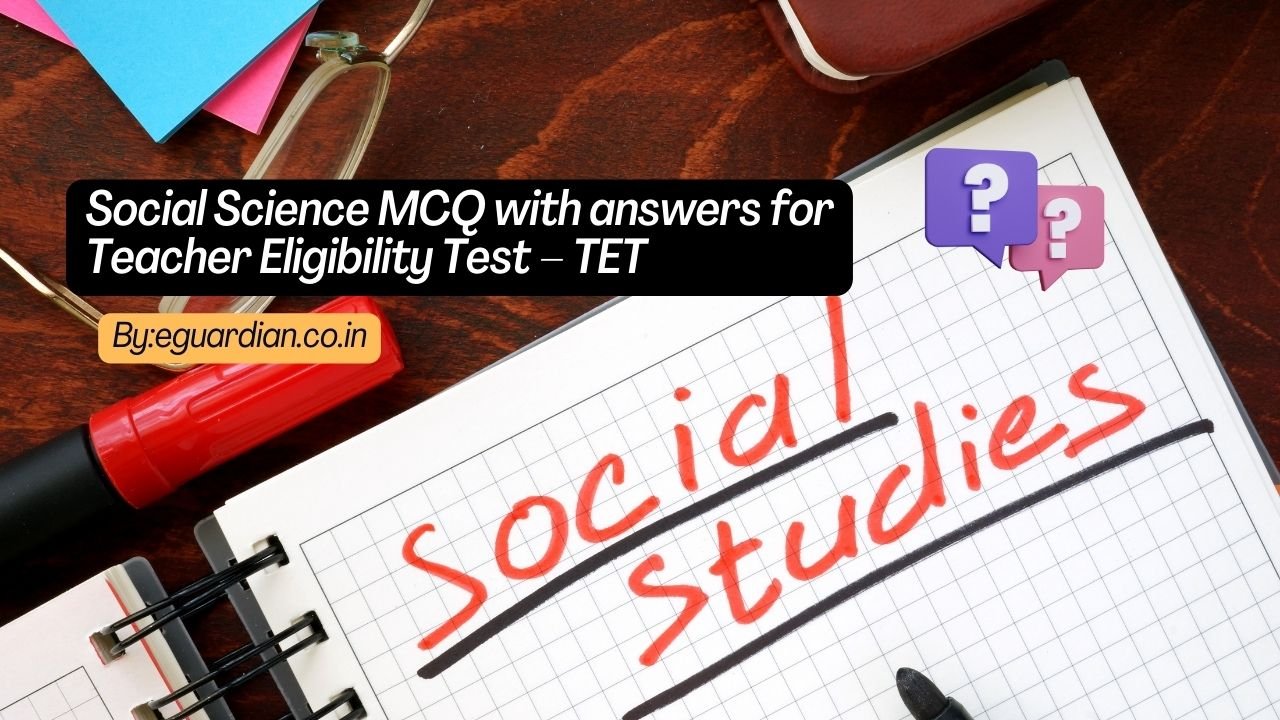TET exam model question paper and TET sample paper Science MCQ : Teacher Eligibility Test, known as TET, is an Indian entrance examination for teachers. The test is mandatory for getting teaching jobs in government schools from Class 1 to Class 8.

TET exam model question paper
1. Which lens must be used in a spectacle to cure the hypermelogia defect of the eye?
(a) Convex mirror
(b) Convex lens
(c) Concave lens
(d) None of these
Answer: (b)
2. The red rose seems red because:
(a) It reflects every colour
(b) It does not reflect any colour
(c) It absorbs red color.
(d) It reflects a red colour
Answer: (d)
3. Penicillin was first discovered by
(a) Alexander Fleming
(b) Antony van Leeuwenhoek
(c) S. Waksman
(d) Faraday
Answer: (a)
4. The best medicine to inject into the snake bite case is
(a) Penicillin
(b) Antivenin
(c) Terramycin
(d) Streptomycin
Answer: (b)
5. Which of the following is a useful organism?
(a) Honey bee
(b) Lac insect
(c) Silkworm
(d) All of these
Answer: (d)
6. On heating, the liquid is converted into a gaseous state. This process is called
(a) Sublimation
(b) Evaporation
(c) Diffusion
(d) Vapourisation
Answer: (d)
7. The chemical formula of a compound represents
(a) The total number of atoms in a molecule of the compound
(b) The number of various atoms in one molecule of the compound
(c) The composition of a molecule of the compound
(d) All of these
Answer: (d)
8. The main sources of protons are:
(a) Cereals
(b) Fruits and vegetables
(c) Oils
(d) Soybean
Answer: (d)
9. The father of the green revolution in India is:
(a) Menaka Gandhi
(b) R.S Aggarwal
(c) M.S. Swaminathan
(d) Santosh Yadav
Answer: (c)
10. Which of the following processes does not replenish the soil with nutrients?
(a) Manuring
(b) Crop rotation
(c) Use of fertilizers
(d) Ploughing
Answer: (d)
11. Who is known as the ‘Father of Biology’?
(a) Faranday
(b) Darwin
(c) Aristotle
(d) Robert hook
Answer: (c)
12. The correct sequence of taxonomic categories is
(a) Division – family – class – order – genus – species
(b) Division – class – order – family – genus – species
(c) Phylum – order – class – family – genus – species
(d) Class – order – phylum – genus – family – species
Answer: (b)
13. Which of the following is not a Kharif crop?
(a) Wheat
(b) Clover
(c) Legumes
(d) All of these
Answer: (d)
14. Which lens must be used in a spectacle to cure the hypermelogia defect of the eye?
(a) Convex mirror
(b) Convex lens
(c) Concave lens
(d) None of these
Answer: (b)
15. Cholesterol is related to
(a) Fats
(b) Starch
(c) Molases
(d) Vitamin C
Answer: (a)
16. The state in which molecular attractions are the least
(a) Solid
(b) Liquid
(c) Gas
(d) None of these
Answer: (c)
17. Intermolecular space is the maximum in
(a) Water
(b) Steam
(c) Ice
(d) All of them
Answer: (b)
18. The process of converting solids into liquid on heating called
(a) Evaporation
(b) Condensation
(c) Diffusion
(d) Sublimation
Answer: (d)
19. Which of the following is not a chemical change?
(a) Rusting of iron
(b) Converting water into ice
(c) Marking curd from milk
(d) Burning of paper
Answer: (b)
20. In a balanced chemical equation, the reactant side and the product side have the same number of
(a) Atoms
(b) Neutrons
(c) Protons
(d) Electrons
Answer: (a)
21. A balanced diet should have
(a) Protein 2/5, fat 3/5, carbohydrate 1/5
(b) Protein 3/5, fat 1/5, carbohydrate 2/5
(c) Protein 1/5, fat 1/5, carbohydrate 3/5
(d) Protein 1/2, fat ¾, carbohydrate 1/4
Answer: (c)
22. Which of the following statements about a balanced chemical equation is not true?
(a) Mass is conserved only
(b) Atoms are conserved only
(c) Molecules are conserved only
(d) All of these
Answer: (d)
23. Atomic theory was given by
(a) John Dalton
(b) Neils Bohr
(c) E. Rutherford
(d) J.J Thomson
Answer: (a)
24. If we open a bottle of perfume, its smell spreads in the entire room within a short time due to the process of
(a) Evaporation
(b) Sublimation
(c) Diffusion
(d) Solution
Answer: (c)
25. Which out of the following is a heterogeneous mixture?
(a) Milk
(b) Soil
(c) Smoke
(d) All of these
Answer: (d)
26. Carbon dioxide is a compound because:
(a) It exists as a solid liquid or gas.
(b) It contains hydrogen and oxygen.
(c) It contains two different elements joined by chemical bonds.
(d) It can be split up into simpler substance by chemical means
Answer: (c)
27. Which of the following is neither an element nor a compound?
(a) Saline water
(b) Carbon dioxide
(c) Mercury
(d) Sodium chloride
Answer: (a)
28. The atomicity of aluminum is
(a) 1
(b) 2
(c) 3
(d) 4
Answer: (a)
29. The chemical formula of a compound containing 2 atoms of hydrogen and 1 atom of sulphur is
(a) H2SO4
(b) SO2
(c) H2S
(d) H2O
Answer: (c)
30. When magnesium is burned in the air, it produces magnesium oxide. The correct chemical reaction is:
(a) Mg +O2 ®MgO
(b) 2 2Mg +O ®2MgO
(c) 2Mg + 2O®2MgO
(d) 2 Mg2 +O ®2MgO
Answer: (b)
31. Marasmus is likely in children who get
(a) Low-iron diet
(b) Low diet
(c) low-fat diet
(d) low-protein diet
Answer: (b)
32. Citrus fruit is a source of
(a) Vitamin B
(b) Vitamin C
(c) Iodine
(d) Vitamin A
Answer: (b)
33. Calcium deficiency occurs in the absence of vitamin
(a) D
(b) K
(c) C
(d) A
Answer: (a)
34. Which of the following sets includes the bacterial disease?
(a) Diphtheria, SARS, and Common Cold
(b) Malaria, leprosy, and typhoid
(c) Tetanus, Tuberculosis, and Measles
(d) Malaria, Mumps, and Swine Flue
Answer: (c)
35. The electrolyte used in the voltaic cell is:
(a) Sulphuric acid
(b) Phosphoric acid
(c) Nitric acid
(d) Carbonic acid
Answer: (a)
36. If three resistances of 20 W, 15 W, and 20 W are connected in series, the equivalent resistance will be:
(a) 45W
(b) 60W
(c) 25W
(d) 55W
Answer: (d)
37. The resistance of a conductor ___ with a rise in temperature.
(a) Increases
(b) Decreases
(c) Remains the same
(d) First increases, then decreases
Answer: (a)
38. The wire having a black plastic covering is a
(a) Live wire
(b) Neutral wire
(c) Earth wire
(d) None of these
Answer: (b)
39. Electromagnets are used in
(a) Electric bells
(b) Telephones
(c) Dynamos
(d) None of these
Answer: (a)
40. Which of the following diseases is caused by a virus?
(a) Dysentery
(b) T.B
(c) Influenza
(d) Malaria
Answer: (c)
41. Which of the following animals has a gall bladder?
(a) Lion
(b) Dog
(c) Human
(d) All of these
Answer: (d)
42. Germs entering the body through food are mainly killed in the region of alimentary
the canal where pH may reach the level.
(a) 2
(b) 3
(c) 9
(d) Infinity
Answer: (a)
43. The canine tooth is meant for
(a) Biting and cutting
(b) Chewing
(c) Tearing
(d) Grinding
Answer: (c)
44. The experiment which led to the discovery of proton was performed by
(a) Goldstein
(b) J.J Thomson
(c) Dalton
(d) Rutherford
Answer: (a)
45. An element has electronic configuration 2,8,3. It will be classified as
(a) Metal
(b) Non-metal
(c) Metalloid
(d) None of these
Answer: (a)
46. Which of the following is not a mineral acid?
(a) HCl
(b) H2SO4
(c) HNO3
(d) CH3COOH
Answer: (d)
47. Which of the following acids is present in lemon?
(a) Glycolic acid
(b) Lactic acid
(c) Citrus acid
(d) Tartaric acid
Answer: (c)
48. Which of the following is not an organic acid?
(a) Tartaric acid
(b) Oxalic acid
(c) Ascorbic acid
(d) Sulphuric acid
Answer: (d)
49. Which of the following is not an acidic salt?
(a) CuSO4
(b) MgCO3
(c) ZnSO4
(d) NH4NO3
Answer: (b)
50. Sodium chloride is a salt of
(a) Weak acid and a weak base
(b) Weak acid and strong base
(c) Strong acid and a strong base
(d) Strong acid and a weak base
Answer: (c)


tha slected for pet paper